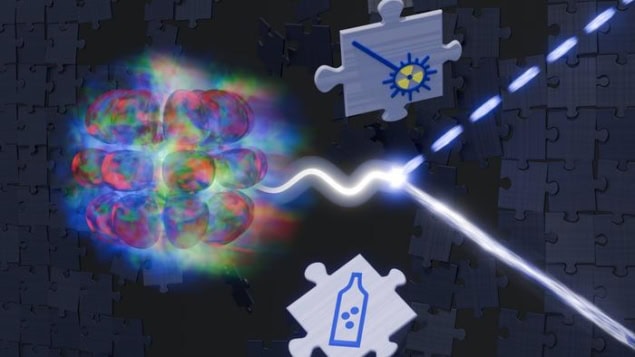
Neutrons inside the atomic nucleus are incredibly stable, but free neutrons decay within 15 minutes – give or take a few seconds. The reason we don’t know this figure more precisely is that the two main techniques used to measure it produce conflicting results. This so-called neutron lifetime problem has perplexed scientists for decades, but now physicists at TU Wien in Austria have come up with a possible explanation. The difference in lifetimes, they say, could stem from the neutron being in not-yet-discovered excited states that have different lifetimes as well as different energies.
According to the Standard Model of particle physics, free neutrons undergo a process called beta decay that transforms a neutron into a proton, an electron and an antineutrino. To measure the neutrons’ average lifetime, physicists employ two techniques. The first, known as the bottle technique, involves housing neutrons within a container and then counting how many of them remain after a certain amount of time. The second approach, known as the beam technique, is to fire a neutron beam with a known intensity through an electromagnetic trap and measure how many protons exit the trap within a fixed interval.
Researchers have been performing these experiments for nearly 30 years but they always encounter the same problem: the bottle technique yields an average neutron survival time of 880 s, while the beam method produces a lifetime of 888 s. Importantly, this eight-second difference is larger than the uncertainties of the measurements, meaning that known sources of error cannot explain it.
A mix of different neutron states?
A team led by Benjamin Koch and Felix Hummel of TU Wien’s Institute of Theoretical Physics is now suggesting that the discrepancy could be caused by nuclear decay producing free neutrons in a mix of different states. Some neutrons might be in the ground state, for example, while others could be in a higher-energy excited state. This would alter the neutrons’ lifetimes, they say, because elements in the so-called transition matrix that describes how neutrons decay into protons would be different for neutrons in excited states and neutrons in ground states.
As for how this would translate into different beam and bottle lifetime measurements, the team say that neutron beams would naturally contain several different neutron states. Neutrons in a bottle, in contrast, would almost all be in the ground state – simply because they would have had time to cool down before being measured in the container.
Towards experimental tests
Could these different states be detected? The researchers say it’s possible, but they caution that experiments will be needed to prove it. They also note that theirs is not the first hypothesis put forward to explain the neutron lifetime discrepancy. Perhaps the simplest explanation is that the gap stems from unknown systematic errors in either the beam experiment, the bottle experiment, or both. Other, more theoretical approaches have also been proposed, but Koch says they do not align with existing experimental data.
“Personally, I find hypotheses that require fewer and smaller new assumptions – and that are experimentally testable – more appealing,” Koch says. As an example, he cites a 2020 study showing that a phenomenon called the inverse quantum Zeno effect could speed up the decay of bottle-confined neutrons, calling it “an interesting idea”. Another possible explanation of the puzzle, which he says he finds “very intriguing” has just been published and describes the admixture of novel bound electron-proton states in the final state of a weak decay, known as “Second Flavor Hydrogen Atoms”.

Space-based spectrometer enters neutron lifetime debate
As someone with a background in quantum gravity and theoretical physics beyond the Standard Model, Koch is no stranger to predictions that are hard (and sometimes impossible, at least in the near term) to test. “Contributing to the understanding of a longstanding problem in physics with a hypothesis that could be experimentally tested soon is therefore particularly exciting for me,” he tells Physics World. “If our hypothesis of excited neutron states is confirmed by future experiments, it would shed a completely new light on the structure of neutral nuclear matter.”
The researchers now plan to collaborate with colleagues from the Institute for Atomic and Subatomic Physics at TU Wien to revaluate existing experimental data and explore various theoretical models. “We’re also hopeful about designing experiments specifically aimed at testing our hypothesis,” Koch reveals.
The present study is detailed in Physical Review D.



